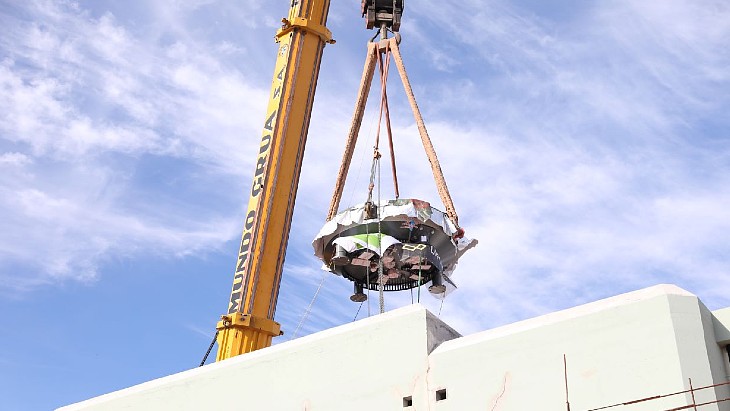The centre is being built in Buenos Aires, next to the Nuclear Diagnostic Center Foundation and is a joint project between Argentina's National Atomic Energy Commission (CNEA), the University of Buenos Aires and construction company INVAP.
Luis Rovere, vice president of the CNEA, called it a "very important milestone" with the cyclotron being the main machine for the Proton Therapy Centre, which is described as the first proton centre for the treatment of cancer in the southern hemisphere. He said: "We estimate that the first tests could begin in the second half of 2025."
The operation was carried out by Belgian company Ion Beam Applications, supplier of the equipment.
The C230 cyclotron, from the Proteus Plus system, is a circular particle accelerator that produces beams of protons. It is located in a secure space with concrete walls up to four metres wide, which meant that the lifting and placing of the lower and upper halfs of the cyclotron had to be a precision operation.
According to INVAP: "Unlike the photon beam used in conventional radiotherapy, proton therapy uses high-energy protons directing higher doses to the tumour area without increasing the doses in other areas. The large mass of these protons prevents them from undergoing changes in their path to the tumour, allowing them to be more precisely directed to the affected tissues thereby minimising adverse effects on healthy tissues or organs."
The precision of the treatment, says INVAP, makes it "ideal for treating tumours that are difficult to access or surrounded by vital structures such as brain, head and neck, or lung tumours. It is also a very safe option for treating paediatric tumours since the treatment produces fewer side effects in growing bodily structures".
The Proton Therapy Centre will also offer radiotherapy with high energy X-rays and will also feature a CyberKnife linear accelerator for radiosurgery, with a robotic arm that moves and irradiates while visualising the tumour through real-time radiographic images. There will also be a magnetic resonator and a dual energy tomograph. In addition, there will be a dedicated Research, Development and Innovation laboratory at the site, separate from the clinical areas.





_18570.jpg)
_18938.jpg)
_33584.jpg)
_82983.jpg)





